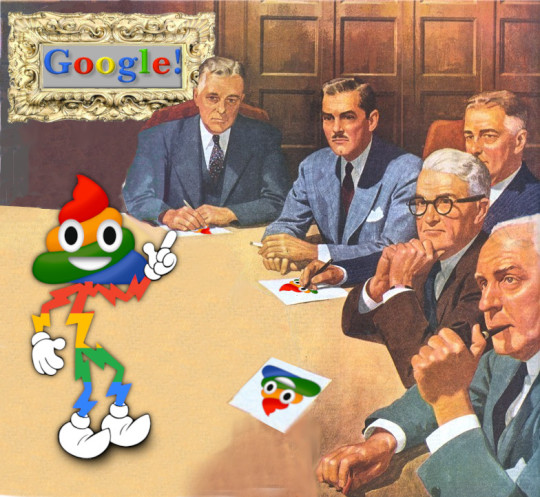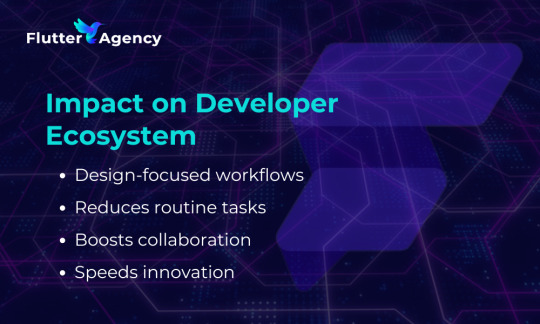#No-code platform
Explore tagged Tumblr posts
Text
The Future of FlutterFlow With Low-Code Development
Discover how FlutterFlow is shaping the future of app development, driving the $187B low-code revolution with faster, cost-effective solutions.
0 notes
Text
Top 8 No-Code Platforms for Healthcare
The healthcare industry increasingly relies on digital solutions to improve patient care, streamline operations, and maintain compliance with strict regulations. No-code platforms have emerged as vital tools, enabling healthcare organizations to build customized applications quickly and with minimal coding knowledge. Here, we explore the top 8 no-code platforms that are particularly well-suited for healthcare applications:
1. Kovaion’s No-code Platform
Kovaion’s no code platform stands out as a premier no-code solution tailored for the healthcare industry. It provides a highly intuitive platform that allows healthcare providers to create applications focused on patient management, electronic health records (EHR), and compliance with healthcare regulations such as HIPAA. Its robust suite of pre-built healthcare components and seamless integration capabilities make it an excellent choice for healthcare organizations aiming to enhance operational efficiency and patient outcomes.

Here are the features incorporated into Kovaion’s No-Code Platform:
AI-Powered App Builder
Advanced Form Builder
Drag & Drop Workflows
Interactive Dashboards
Responsive Application
Email Notifications
Seamless Integration
Attractive BI Dashboard
API Integration
OTP based Login
User role management (based on fields)
2. Mendix
Mendix offers a powerful no-code environment that enables healthcare organizations to develop applications that optimize patient engagement and operational efficiency. Its strong security features and extensive integration options ensure that sensitive healthcare data is handled securely.
3. Microsoft PowerApps
As part of the Microsoft ecosystem, PowerApps allows healthcare organizations to develop applications that leverage their existing Microsoft software investments. This platform is particularly useful for creating solutions that require deep integration with Microsoft’s Azure and Office 365.
4. OutSystems
Known for its rapid application development capabilities, OutSystems provides healthcare institutions with a secure and scalable platform to create extensive custom applications that adhere to compliance standards.
5. Appian
Appian’s no-code platform excels in automating business processes and improving workflow efficiencies. Healthcare providers can benefit from its strong BPM capabilities to enhance patient management and care coordination.
6. Salesforce Health Cloud
Built on the Salesforce platform, Health Cloud is designed to create personalized patient experiences. It integrates patient data into a single platform, providing healthcare workers with powerful tools to manage patient relationships better and coordinate care more effectively.
7. Zoho Creator
Zoho Creator offers an accessible no-code platform ideal for smaller healthcare facilities that need custom applications without heavy investment. It provides easy data management and compliance with healthcare regulations, making it a practical choice for budget-conscious providers.
8. Nintex
Nintex specializes in workflow automation, which is crucial for the healthcare sector. Its platform allows for creating streamlined workflows for patient data management and improving the overall efficiency of healthcare operations.
These no-code platforms equip healthcare organizations with essential tools to navigate the fast-evolving digital landscape, ensuring they meet patient needs and maintain compliance with stringent industry regulations. Among these options, Kovaion stands out as the superior choice due to its focused commitment to healthcare. It offers specialized features and functionalities tailored specifically for the sector, making Kovaion the best option for organizations aiming to fully harness the benefits of no-code application development in healthcare.
0 notes
Text
Utilizing Low-Code Software's Potential through Scalability and Flexibility
Learn how low-code software solutions are enabling businesses to expand and adapt in the fast-paced market environment of today by exploring their scalability and adaptability. Discover how low-code platforms are helping companies to easily scale their apps and satisfy changing user demands, from seamless integrations to configurable processes.

0 notes
Text
The specific process by which Google enshittified its search

I'm touring my new, nationally bestselling novel The Bezzle! Catch me SATURDAY (Apr 27) in MARIN COUNTY, then Winnipeg (May 2), Calgary (May 3), Vancouver (May 4), and beyond!

All digital businesses have the technical capacity to enshittify: the ability to change the underlying functions of the business from moment to moment and user to user, allowing for the rapid transfer of value between business customers, end users and shareholders:
https://pluralistic.net/2023/02/19/twiddler/
If you'd like an essay-formatted version of this thread to read or share, here's a link to it on pluralistic.net, my surveillance-free, ad-free, tracker-free blog:
https://pluralistic.net/2024/04/24/naming-names/#prabhakar-raghavan
Which raises an important question: why do companies enshittify at a specific moment, after refraining from enshittifying before? After all, a company always has the potential to benefit by treating its business customers and end users worse, by giving them a worse deal. If you charge more for your product and pay your suppliers less, that leaves more money on the table for your investors.
Of course, it's not that simple. While cheating, price-gouging, and degrading your product can produce gains, these tactics also threaten losses. You might lose customers to a rival, or get punished by a regulator, or face mass resignations from your employees who really believe in your product.
Companies choose not to enshittify their products…until they choose to do so. One theory to explain this is that companies are engaged in a process of continuous assessment, gathering data about their competitive risks, their regulators' mettle, their employees' boldness. When these assessments indicate that the conditions are favorable to enshittification, the CEO walks over to the big "enshittification" lever on the wall and yanks it all the way to MAX.
Some companies have certainly done this – and paid the price. Think of Myspace or Yahoo: companies that made themselves worse by reducing quality and gouging on price (be it measured in dollars or attention – that is, ads) before sinking into obscure senescence. These companies made a bet that they could get richer while getting worse, and they were wrong, and they lost out.
But this model doesn't explain the Great Enshittening, in which all the tech companies are enshittifying at the same time. Maybe all these companies are subscribing to the same business newsletter (or, more likely, buying advice from the same management consultancy) (cough McKinsey cough) that is a kind of industry-wide starter pistol for enshittification.
I think it's something else. I think the main job of a CEO is to show up for work every morning and yank on the enshittification lever as hard as you can, in hopes that you can eke out some incremental gains in your company's cost-basis and/or income by shifting value away from your suppliers and customers to yourself.
We get good digital services when the enshittification lever doesn't budge – when it is constrained: by competition, by regulation, by interoperable mods and hacks that undo enshittification (like alternative clients and ad-blockers) and by workers who have bargaining power thanks to a tight labor market or a powerful union:
https://pluralistic.net/2023/11/09/lead-me-not-into-temptation/#chamberlain
When Google ordered its staff to build a secret Chinese search engine that would censor search results and rat out dissidents to the Chinese secret police, googlers revolted and refused, and the project died:
https://en.wikipedia.org/wiki/Dragonfly_(search_engine)
When Google tried to win a US government contract to build AI for drones used to target and murder civilians far from the battlefield, googlers revolted and refused, and the project died:
https://www.nytimes.com/2018/06/01/technology/google-pentagon-project-maven.html
What's happened since – what's behind all the tech companies enshittifying all at once – is that tech worker power has been smashed, especially at Google, where 12,000 workers were fired just months after a $80b stock buyback that would have paid their wages for the next 27 years. Likewise, competition has receded from tech bosses' worries, thanks to lax antitrust enforcement that saw most credible competitors merged into behemoths, or neutralized with predatory pricing schemes. Lax enforcement of other policies – privacy, labor and consumer protection – loosened up the enshittification lever even more. And the expansion of IP rights, which criminalize most kinds of reverse engineering and aftermarket modification, means that interoperability no longer applies friction to the enshittification lever.
Now that every tech boss has an enshittification lever that moves very freely, they can show up for work, yank the enshittification lever, and it goes all the way to MAX. When googlers protested the company's complicity in the genocide in Gaza, Google didn't kill the project – it mass-fired the workers:
https://medium.com/@notechforapartheid/statement-from-google-workers-with-the-no-tech-for-apartheid-campaign-on-googles-indiscriminate-28ba4c9b7ce8
Enshittification is a macroeconomic phenomenon, determined by the regulatory environment for competition, privacy, labor, consumer protection and IP. But enshittification is also a microeconomic phenomenon, the result of innumerable boardroom and product-planning fights within companies in which would-be enshittifiers try to do things that make the company's products and services shittier wrestle with rivals who want to keep things as they are, or make them better, whether out of principle or fear of the consequences.
Those microeconomic wrestling-matches are where we find enshittification's heroes and villains – the people who fight for the user or stand up for a fair deal, versus the people who want to cheat and wreck to make things better for the company and win bonuses and promotions for themselves:
https://locusmag.com/2023/11/commentary-by-cory-doctorow-dont-be-evil/
These microeconomic struggles are usually obscure, because companies are secretive institutions and our glimpses into their deliberations are normally limited to the odd leaked memo, whistleblower tell-all, or spectacular worker revolt. But when a company gets dragged into court, a new window opens into the company's internal operations. That's especially true when the plaintiff is the US government.
Which brings me back to Google, the poster-child for enshittification, a company that revolutionized the internet a quarter of a century ago with a search-engine that was so good that it felt like magic, which has decayed so badly and so rapidly that whole sections of the internet are disappearing from view for the 90% of users who rely on the search engine as their gateway to the internet.
Google is being sued by the DOJ's Antitrust Division, and that means we are getting a very deep look into the company, as its internal emails and memos come to light:
https://pluralistic.net/2023/10/03/not-feeling-lucky/#fundamental-laws-of-economics
Google is a tech company, and tech companies have literary cultures – they run on email and other forms of written communication, even for casual speech, which is more likely to take place in a chat program than at a water-cooler. This means that tech companies have giant databases full of confessions to every crime they've ever committed:
https://pluralistic.net/2023/09/03/big-tech-cant-stop-telling-on-itself/
Large pieces of Google's database-of-crimes are now on display – so much, in fact, that it's hard for anyone to parse through it all and understand what it means. But some people are trying, and coming up with gold. One of those successful prospectors is Ed Zitron, who has produced a staggering account of the precise moment at which Google search tipped over into enshittification, which names the executives at the very heart of the rot:
https://www.wheresyoured.at/the-men-who-killed-google/
Zitron tells the story of a boardroom struggle over search quality, in which Ben Gomes – a long-tenured googler who helped define the company during its best years – lost a fight with Prabhakar Raghavan, a computer scientist turned manager whose tactic for increasing the number of search queries (and thus the number of ads the company could show to searchers) was to decrease the quality of search. That way, searchers would have to spend more time on Google before they found what they were looking for.
Zitron contrasts the background of these two figures. Gomes, the hero, worked at Google for 19 years, solving fantastically hard technical scaling problems and eventually becoming the company's "search czar." Raghavan, the villain, "failed upwards" through his career, including a stint as Yahoo's head of search from 2005-12, a presiding over the collapse of Yahoo's search business. Under Raghavan's leadership, Yahoo's search market-share fell from 30.4% to 14%, and in the end, Yahoo jettisoned its search altogether and replaced it with Bing.
For Zitron, the memos show how Raghavan engineered the ouster of Gomes, with help from the company CEO, the ex-McKinseyite Sundar Pichai. It was a triumph for enshittification, a deliberate decision to make the product worse in order to make it more profitable, under the (correct) belief that the company's exclusivity deals to provide search everywhere from Iphones and Samsungs to Mozilla would mean that the business would face no consequences for doing so.
It a picture of a company that isn't just too big to fail – it's (as FTC Chair Lina Khan put it on The Daily Show) too big to care:
https://www.youtube.com/watch?v=oaDTiWaYfcM
Zitron's done excellent sleuthing through the court exhibits here, and his writeup is incandescently brilliant. But there's one point I quibble with him on. Zitron writes that "It’s because the people running the tech industry are no longer those that built it."
I think that gets it backwards. I think that there were always enshittifiers in the C-suites of these companies. When Page and Brin brought in the war criminal Eric Schmidt to run the company, he surely started every day with a ritual, ferocious tug at that enshittification lever. The difference wasn't who was in the C-suite – the difference was how freely the lever moved.
On Saturday, I wrote:
The platforms used to treat us well and now treat us badly. That's not because they were setting a patient trap, luring us in with good treatment in the expectation of locking us in and turning on us. Tech bosses do not have the executive function to lie in wait for years and years.
https://pluralistic.net/2024/04/22/kargo-kult-kaptialism/#dont-buy-it
Someone on Hacker News called that "silly," adding that "tech bosses do in fact have the executive function to lie in wait for years and years. That's literally the business model of most startups":
https://news.ycombinator.com/item?id=40114339
That's not quite right, though. The business-model of the startup is to yank on the enshittification lever every day. Tech bosses don't lie in wait for the perfect moment to claw away all the value from their employees, users, business customers, and suppliers – they're always trying to get that value. It's only when they become too big to care that they succeed. That's the definition of being too big to care.
In antitrust circles, they sometimes say that "the process is the punishment." No matter what happens to the DOJ's case against Google, its internal workers have been made visible to the public. The secrecy surrounding the Google trial when it was underway meant that a lot of this stuff flew under the radar when it first appeared. But as Zitron's work shows, there is plenty of treasure to be found in that trove of documents that is now permanently in the public domain.
When future scholars study the enshittocene, they will look to accounts like Zitron's to mark the turning points from the old, good internet to the enshitternet. Let's hope those future scholars have a new, good internet on which to publish their findings.

If you'd like an essay-formatted version of this post to read or share, here's a link to it on pluralistic.net, my surveillance-free, ad-free, tracker-free blog:
https://pluralistic.net/2024/04/24/naming-names/#prabhakar-raghavan
#pluralistic#ed zitron#google#microincentives#constraints#enshittification#rot economy#platform decay#search#ben gomes#code yellow#mckinsey#hacking engagement#Prabhakar Raghavan#yahoo#doj#antitrust#trustbusting
509 notes
·
View notes
Text
Queendom is giving me color-coded girls in love!

But it's doing it in the simplest yet smartest way!

Rey is the cold-coded character with her blacks and blues.

Print is the more warm-colored character with her pinks and reds.

But they get in trouble.

AND SWITCH BODIES!

And because they switch bodies, they take their colors with them!

It's a smart way to remember that Print is in Rey's body and Rey is in Print's body because of the color.

So when their colors merge (a color exchange), it'll signify more than them just being in love, but that they are close to returning to their original bodies.

This shot is the perfect example of why I'm so excited! (I'm looking at the mirror since it has both of their colors, not her ass)

Well . . . maybe I am excited for several reasons.

#queendom#thai gl#I'm surprisingly very excited for this show now!#WeTV continues to give us good shows#I hate their streaming platform#but I sure do love these shows#especially when they involve beautiful women and colors!#the colors mean things#color coded girls in love
112 notes
·
View notes
Text
need to say that he's a bad dog in front of his face just to see the reaction

#IM SO SORRY but this pic is SOOO dog coded#i cant say it on the other platform so imma say it here#also how do i make this abt marcmarc#LIKE IMAGINE HIM BEING UPSET OMG#ykw im erect /j#ignore that uhhh#marco bezzecchi#mb72
54 notes
·
View notes
Text

[ID: A digital doodle page of Impulse, drawn as a demon with small horns, a spaded tail, and small, underdeveloped wings. The rightmost drawing is a full body of his Hermitcraft 10 skin, it's mostly uncolored with some yellow and pink accents. A png of the skin is next to it
There's other two drawings: one with his normal outfit where he's facing away, showing his wings, and another where he's smiling nervous, yet triumphant. In this last drawing, he's fully human, and he's wearing a turtleneck and a jacket. /End ID]
I wasn't sure if I should draw full bodies, icons, or what, so I decided to just do whatever I felt like doing. Today, that's a doodle page! Featuring default, s10, and Phasmophobia Impulse.
#hermitaday#hermitcraft#impulsesv#impulse fanart#ice draws#fun fact! the yelllow accents on the platforms of his boots say 'imp' in morse code#hadm 2025
35 notes
·
View notes
Text
You are still short and always will be ☔🚬



Trust me, this really happened, Yuma having to put up with the jokes and comments about his height. Whenever he says "when I was little", someone will always remind him that he is STILL little, imagine when Yuma was a baby or a child, he was super short. (I was)
Aaaahh, I remember my old headcanon of him was 23 years old during the game, and that he would be short like that because he didn't take care of himself when he was young. 😌
Tw: spoiler ☔⚠️
Like, I think maybe he became a detective and Number One at a young age and was always a workaholic, making him not take care of his own growth and stay that way even after 18-21, Could it also just be family genetics that he is short, or something supernatural because of his Forte.
I know about the game design context, I'm talking within the game's story, In my head it would make sense that he was 20 years old when Makoto was created, he is clearly of minimum drinking age.

To be honest, I never cared about short characters, always having a negative view, but Yuma made me care because I'm short too, and putting my short problems on him is fun. Thanks Yuma, suffer more :3
I need to draw Yakou more often, he's cool, and I need to practice his and Vivia's hair too. I wonder what Yuma's beta visuals were like, if he was always short, Makoto had a tall design. I read a fanfic of Yuma being older and taller and it was fun and funny. (Guess who wrote it), doubt his look will change in the future, everyone loves the short king. And I think I've always liked the tall x short ship trope.
Everyone who is short, put your problems on Yuma. >:D
#master detective archives: rain code#mdarc#raincode#rain code#yuma kokohead#yakou furio#art#fanart#my art#tw: spoilers#raincode spoilers#spoiler alert#old headcanon#self indulgent#maybe#making Yuma suffer in this way as well as killing him in the stories#short people problems#Pucci and perhaps Desuhiko deserve to suffer from short structure#maybe she doesn't care#Maybe Makoto doesn't suffer so much because he wears platform shoes and a suit#and for being CEO of Amaterasu.
27 notes
·
View notes
Text
A newly established social media platform where you can earn cryptocurrency. The platform is still under development, keeping pace with modern technologies such as cryptocurrency exchange.
https://www.soc-web6.com/share/person/109023952345758776?code=AIHWWPDX
Invitation code: AIHWWPDX
You'll find plenty of explanations on YouTube.

#social media platform#socrates#perseverance#code#soc#earn tokens#Solutions#like#Invitation code#development#Modern generation#Tweet#Space for expression#cryptocurrency
20 notes
·
View notes
Text

Hermittober Day 7: Fall!
I like to imagine Joel tripped a little when he got shot so he could fit the theme of all of the Bread Boys Falling
#hermittober#limited life#grian#smallishbeans#solidaritygaming#jimmy solidarity#joel smallishbeans#bread boys#trafficblr#my art#phoenix draws#hi hi hello i know this is the second bread boys in a row but i can't help it#both prompts where so bread boy coded#aka i couldn't think of anything else for today except for this#idk why i put grian in that outfit#fishnets and platform boots for him i guess#this was a really fun posing and perspective piece too#id like to think i'm getting better at perspective
201 notes
·
View notes
Text



I finished a little reference sheet for Blake! I find it funny how much he has changed in his time existing, he didn't have his hair that long or voluminous(?
I'm trying to take this a little more seriously now, for portafolio purposes and stuff~ I would like to do character designing in the future...
#oc#Blake#MEMORY#original character#digital art#my art#reference sheet#maybe I could add a new type of commission... we'll see#I wanna do another two or three sheets before deciding anything#in the meantime#look at my son!!!!#I'm actually trying out VGen and#man#man.#the options for the character section.#I am in love.#I want a code so I can try to take commissions there too#it seems like a very nice platform!#I'm gonna be uploading some character info there too#maybe I'll put a link to it later#maybe#aaaaaaaaaaa#I want an artist code so baaaaddd AGGGHHH
25 notes
·
View notes
Text
The Future of Low-Code Development: Flutterflow's Evolution

Low-code platforms have become a game-changer, especially for startups with speedy launches in mind in the fast-paced global software development scenario.
These platforms help in building apps with the use of visual interfaces and drag-and-drop tools that provide an easier environment to develop applications reducing the prevalence of conventional coding knowledge.
Especially beneficial for smaller startups with fewer resources, this method allows businesses to develop and deploy mobile apps quickly, iterate rapidly fast as well, and help merchants concentrate on innovation over complex code.
Nothing beats low-code in the modern way we develop software! Since there is a lot of pressure on startups to meet tight deadlines and budget constraints, these platforms have only helped in saving time.
Low-code development reduces the technical barriers to entry, enabling more people – from full-time developers and citizen creators alike — to be involved in creating apps, leading us towards a broader view of what an agile developer looks like.
Flutterflow is a great example of the things happening in low-code development. Developed on Google's Flutter framework, users can build fully functional mobile applications without the need to write long lines of code using the app-building platform—Flutterflow.
With its simple UI, it comes with features that make it great in mobile app development especially for startups. In addition to speeding up your workflow, Flutterflow gives you the ability to drop in custom code whenever needed which will remedy any inefficiencies pent-up from using visual tools while designing in a way that remains easy enough accessible for beginners.
With the mobile app development for startups demand growing ever larger, Flutterflow comes through as a wind of stiff breeze in a low code world balancing being user-friendly and feature-rich.
Low-Code Platforms Going Mainstream
Factors Behind Increasing Low-Code Adoption

Some of the key trends that are driving the rise in low-code platforms, including mobile app development for a startup:
Increasing Demand for Faster Development Cycles: Startups have to get their products out in the market faster or face losing out on business. This enables low-code platforms for quick prototyping and deployment, which helps to reduce time-to-market.
Shortage of Skilled Developers: There is a shortage of developers, with great demand for software solutions. Low-code platforms map to this inverse need, allowing less technical users the ability to build basic yet functional applications.
Need for More Accessible Development Tools: Inclusion of non-developers and business users in the development process. Low-code platforms are created for the non-technical user.
Benefits of Low-Code Development

Speed and Efficiency in App Creation: Low-code platforms provide a way to streamline app development, which allows you faster creation (and iteration) of mobile apps — an absolute necessity for startups.
Cost-Effectiveness: As the low-code platforms tend to lower down all that extensive coding and specialized skills needs, it becomes a cost-effective technology for startups.
Empowering Citizen Developers: Low-code tools empower citizen developers to get involved in app development, therefore applying innovation that might not have been viewed otherwise — enabling startups with a broader set of ideas and skills.
Why Flutterflow Stands Out

Integration with Flutter
Flutter —(made by Google) is a popular native UI toolkit for cross-platform development on Mobile, Web, and Desktop
Its benefits include:
Write Once, Deploy Anywhere: need to write platform-specific code in one shared library.
Performance is Key: Flutter provides 60-120 fps animations and fast responses to user input, delivering a superior app experience.
Flexible Widgets: It comes with a rich set of flexible widgets that helps you to develop polished and customized UI.
Building on these capabilities, Flutterflow is a low-code platform that preserves the strengths of Flutter as well as makes app development even more accessible.
Because of Flutter's powerful framework, making a quality mobile app with minimal coding expertise is made possible by Flutterflow; great for startups wanting to develop mobile apps.
Key Features of Flutterflow

Visual Development Environment: Provides an easy-to-use drag-and-drop interface that makes creating Android Applications as easy and quick as possible.
Building with Custom Code: Flutterflow has made it easy to build without any code, however, for added flexibility and functionality custom coding can always be integrated.
Pre-Built Templates and Components: Some various in-build templates and components will help you to fasten the process of development which results consistently in one place with the user interface.
Real-Time Collaboration and Feedback: While collaborating in real-time, teams readily iterate on designs and implement changes faster.
Use Cases
Examples of Flutterflow Projects Built Efficiently
A startup rapidly launching an MVP for a mobile app, reducing development time from months to weeks.
A non-profit organization creating an app to engage its community without needing a full development team.
Types of Industries that will be Benefitted by Flutterflow

Healthcare: For rapid patient management applications or telemedicine solutions.
E-commerce: To quickly launch their mobile shopping platforms used for startups.
Education: Interactive learning tools and platforms that need quick iteration + deployment.
With all the powerful features mentioned above and greater versatility, Flutterflow is an excellent choice for any startups or businesses willing to make their custom mobile app development less complicated.
What Is the Future of Flutterflow in Low-Code Development

Upcoming Features and Roadmap
However, as Flutterflow continues to grow other interesting updates are going to be introduced over time making it powerful, especially for mobile app development startups.
It is expected that future updates will continue to enhance the platform by providing powerful UI/UX design tools, improving performance, and extending integration with third-party services. These new features should make Flutterflow even more powerful and easier to work with.
A roadmap might also include tighter integration with cloud services, AI-based development assistance, and extended platform support like wearables or IoT. You can create fantastic new tools and integrations that help startups build applications, which keeps you ahead of the competition.
How It Affects the Developer Ecosystem

Flutterflow has the potential to disrupt the status quo of traditional development practices and move the needle for the developer ecosystem.
As low code is getting steam and platforms like Flutterflow are growing, this may lead to moving the field from manual coding towards design-centric workflows.
This may reduce the necessity of highly specialized developers to conduct monotonous tasks and take their focus on new complex task which has scale.
Additionally, Flutterflow plays a major role in collapsing that wall between developers and non-developers. This democratization of app building helps the platform promote a more balanced renewable workflow structure, whereby any layman can take part in making apps and expediting their fruition.
First and foremost, this democratization of development speeds-driven innovation which is particularly essential for startups where agility and velocity are qualities that spell the difference between success or failure.
Challenges and Considerations

Although a robust low-code solution, several challenges startups ought to contemplate for effective app development are:
Performance Optimization:
While high productivity and ease of use are certainly low-code benefits, the trade-off is that it doesn't generally generate very optimized code, which can cause scalability problems in larger applications.
As a startup, you are likely to need some tweaks of the application performance, especially with huge data processing or very high traffic from users.
It Allows Customization and Flexibility
While Flutterflow does allow custom code injection, users may still be restricted in creating very specific or intricate functionality.
Some parts of the app will likely require more traditional coding in certain contexts, adding both time and complexity to development when compared with using nigiri.
Vendor Lock-In:
Using a particular low-code platform like Flutterflow in essence locks the team into it — resisting changing to another Limited options for flexibility or transitioning from one system to change have various operation and advancement costs.
Startups need to evaluate the scalability of FlutterFlow in the long run and prepare alternative solutions to avoid any single platform dependency.
Security and Compliance:
Some industries might not be comfortable with the level of security or compliance that comes with low-code platforms, for example, finance and healthcare.
Any startup in these verticals should put Flutterflow to the test and will likely also need to layer on some other security practices over time as they scale.
Seamless Integration with Your Systems
One challenge, in general though is to integrate Flutterflow apps with existing legacy or non-standard technologies.
Startups will need to have integration obstacles in mind and be prepared for them, which needs money to do.
Scalability Concerns:
As the startup matures, one may find themselves adding more dependencies as the features being built outpace what a low-code platform can provide.
This means start-ups must also be wary of how scalable Flutterflow is, and be ready to which over upon necessity to the tried and tested methods.
Limited Community Support:
Low-code platforms like Flutterflow will likely have smaller communities and fewer third-party resources than more established development frameworks.
This may present a challenge for startups, as they will struggle to avail supporting modules or get in touch with perfect-use products, and this is where detailed consideration of the development strategy being adopted by them should play an important role.
This Product Is A Little Easier For Non-Developers To Use – There is still some learning curve, but I guess that comes with the territory on almost all popup plugin options.
Flutterflow is built to make application designing easy and anyone can get the hang of it but a few things will be difficult for non-developers, especially those without experience in app development.
Ensuring team members have the training and resources they need to leverage the platform.
Startups can successfully ride the wild wave of low-code development with Flutterflow, provided that they approach these challenges thoughtfully and intentionally: before reaching a compromise between decisions best made without code or limitations on functionality plankton for mobile app success.
Conclusion
At Flutter Agency, we believe that low-code platforms are the building blocks for what may be the future of software development — a revolutionary process that will democratize app creation and speed applications to market. As the increasing need for quick innovation and value-based solutions rises, especially in mobile app development for startups, low-code tools such as Flutterflow are set to revolutionize how this industry operates.
With excellent integration with Flutter and comprehensive features, it seems to be one of the top platforms for connecting pro-developers and non-developers. The ideation stage for a unique custom-built application can be created so instantly, whereas the option of customization is available yet retains its flexibility as perceived necessary for specific business models.
Moving forward, as low code platforms take over like Flutterflow in the software development world. Some of how Flutterflow speeds up development time, reduces dependency on heavy coding skills, and improves team collaboration will help evolve how startups approach mobile app-building.
0 notes
Text
How No-Code Platforms Transform Business Processes?
In the ever-changing digital landscape, businesses continually seek innovative solutions to enhance efficiency and maintain competitiveness. A transformative technology gaining traction is the emergence of no-code platforms. These platforms revolutionize software development by enabling users to create sophisticated applications without coding. This article explores how no-code platforms reshape traditional business processes, unlocking efficiencies, and fueling organizational growth.
No-Code Platforms:
No-code platforms represent a paradigm shift in the way software is developed and deployed. By providing intuitive, drag-and-drop interfaces, these platforms empower users of all skill levels to design and build sophisticated applications. Unlike traditional development methods that require extensive coding knowledge, no-code platforms democratize the development process, allowing business users, such as marketers, analysts, and operations managers, to take an active role in creating custom solutions tailored to their unique needs.

How No-Code Platforms Transform Business Processes?
1. Automation and Efficiency: No-code platforms enable businesses to automate repetitive tasks and streamline workflows, leading to significant time and cost savings. For example, marketing teams can use no-code platforms to automate lead generation processes, reducing manual effort and improving lead conversion rates.
2. Agility and Flexibility: With no-code platforms, businesses can quickly adapt to changing market conditions and customer demands. The agile nature of these platforms allows organizations to rapidly prototype and iterate on new ideas, enabling them to stay ahead of the competition in today’s fast-paced business environment.
3. Empowering Citizen Developers: No-code platforms empower employees across the organization to become citizen developers, enabling them to create custom applications and solutions without relying on IT or development teams. This democratization of development fosters a culture of innovation and collaboration, driving business growth and transformation.
Benefits:
The adoption of no-code platforms offers a multitude of benefits for businesses:
1. Accelerated Time-to-Market: No-code platforms enable rapid application development, allowing businesses to bring new products and services to the market faster.
2. Cost Savings: By eliminating the need for expensive development resources and reducing time spent on coding, businesses can realize significant cost savings.
3. Improved Productivity: No-code platforms simplify the development process, enabling teams to focus on innovation and creativity rather than technical complexities.
4. Enhanced Collaboration: With no-code platforms, cross-functional teams can collaborate more effectively, leading to better outcomes and improved decision-making.
5. Scalability: No-code platforms are inherently scalable, allowing businesses to easily scale their applications and processes as their needs evolve.
Conclusion:
In conclusion, no-code platforms revolutionize software development and business processes, empowering organizations to innovate and thrive in the digital age. Kovaion’s No-Code platform stands out as a leader, offering comprehensive tools and features tailored to diverse business needs. With its intuitive interface and commitment to customer success, Kovaion accelerates innovation and drives growth. Adopting Kovaion’s platform unlocks efficiencies, accelerates innovation, and achieves strategic objectives effortlessly.
0 notes
Text
Nocode Software: Unleash Creativity for Innovation and Quick Modeling
Unlock your creative potential by exploring the world of nocode software. Your ideas may be realized more quickly than ever before without the headache of coding thanks to simple tools for experimentation and rapid prototyping.

0 notes
Text
spotify is absolutely useless, it doesn't even have Rainbow Factory
#ada weblog tag#//also putting something as fundamental as Picking The Song You Wanna Hear behind a paywall???#//uselessest streaming platform in the solar system#//back to saving my playlists as shoddy wikplayer codes i go
34 notes
·
View notes
Note
hiii ive never interacted w you other than rbing sometimes but i just wanted to let you know that theres something ab the wir takeover of your blog ive genuinely loved. like i watched you get into it and then it just slowly took over your blog as you made it your own n like what youre posting now is almost in the territory of unrecognizable from the source material and i just think thats fun :) youre taking the world and characters from the movie and twisting it and adding onto it n idk, its special to me. its your wreck it ralph now. its filling the good sequel shaped space in my heart but way more creative n out there than disney would ever create
I'm glad you're having fun! A lot of people have unfollowed me LOL. I am easily delighted by characters made for a specific purpose and their relationships to that. I like playing toys with the setting and characters because there is a lot of questions that are never explored due to the scope of the movie.
What if the arcade had a GameCube in it for hosting Super Smash Bros. tournaments?
#As far as I'm concerned the sequel doesn't exist because I don't actually remember anything about it#nor do I remember that it exists until somebody brings it up again#I have a lot of questions about how characters in this world would view their identity and their relationship to the game they exist within#What would be the differences between a character from an arcade game and one from a console game? Or a platformer vs an RPG?#How do player characters feel being used as a conduit for something greater? Scripted character deaths undone every new game?#What does it mean to know how to code? To manipulate the reality of the world around you with the possibility of breaking something?#And most importantly. What if King Candy went to Wii Sports and played tennis?#funny talking tag#wir#It's not that deep but what if it was.
30 notes
·
View notes